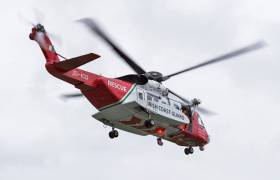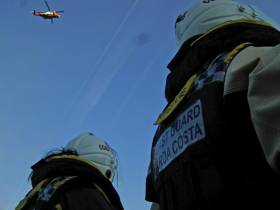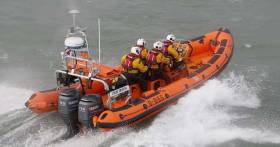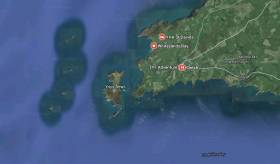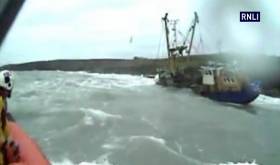Displaying items by tag: trawler
Stricken Trawler Found Off Kerry After Capsize Fears
#Rescue - A fishing trawler in distress off the Irish coast has been found after concerns that it had sunk, as the Irish Examiner reports.
Contact was lost with the 22m Ocean Pioneer after it was left without power some 150km off Kerry on Tuesday (27 March), and crew activated the vessel’s EPIRB emergency beacon to attract the attention of the coastguard.
The signal was picked up by the Irish Coast Guard, which dispatched the Shannon-based helicopter Rescue 115 to the trawler’s last known location.
Not long after, the fishing boat was found with its seven crew unharmed, but the Naval Service vessel LÉ William Butler Yeats was sent to guard the trawler overnight as it presented a risk to over vessels without its lights.
The Irish Examiner has more on the story HERE.
#MCIB - The Marine Casualty Investigation Board (MCIB) will this week begin its inquiry into the sinking of a fishing vessel off Skerries last Friday (26 May) that claimed the life of a local fisherman, according to The Irish Times.
Garda divers recovered the body of 28-year-old Jamie McAllister on Saturday morning, not far from where the fishing trawler went down off the North Dublin coast as previously reported on Afloat.ie.
His crew mate and uncle Keith McAllister was rescued at the scene — and it’s expected that the MCIB will seek an interview this week regarding the circumstances of how their vessel sank while the pair were fishing for razor clams in Force 4 winds.
Earlier this year the five-strong crew of a razor clam vessel fishing in similar conditions were rescued off the nearby Balbriggan coast after their trawler ran aground.
The MCIB previously concluded that dredge fishing for razor clams carries a “high risk” of fouling gear or snagging heavy objects, in its report on the capsize of a fishing boat in Rosslare Harbour in 2015.
A search operation is underway after a fishing trawler sank off the coast of north Dublin this afternoon.
The search effort is ongoing involving the coastguard and the RNLI. Coastguard Helicopter Rescue 116, LE Niamh and LE Orla, along with a number of smaller vessels in the area are participating in the search.
Local RNLI lifeboat crews were tasked to the scene after the vessel went down about 100m off Skerries harbour.
A spokesman for Howth RNLI said its crew were alerted to the sinking before 2pm.
Local reports indicate that one person has been recovered and the search is continuing for a second.
More to follow.
Cantieri Estensi, the Italian builder of these highly appealing lobster boats and trawlers has launched its 535 Maine. After its presentation at the Düsseldorf boat show, the new model was launched this month and makes its debut at the Cannes Yachting Festival in September.
The company says the new 535 Maine follows in the footsteps of the hugely successful previous model, the 530, of which a total of 35 have been sold (rising to 60 when the 480 and 640 sister models are factored in).
Big side windows illuminate the three cabins below deck, while the new solution devised for the door between the cockpit and the saloon makes it possible to create a single space for even more direct contact with the sea. From a technical standpoint, the partnership with Volvo Penta brings all the benefits of electronics to cruising, while innovative fittings like the pivoting swim platform or the joystick to manoeuvre the yacht from the cockpit make life onboard 535 Maine, the ideal “home on the sea”, an even more comfortable experience.
The partnership signed by Cantieri Estensi and Volvo Penta means that 535 Maine can be fitted with all the latest propulsion and steering technology. The engines used are the familiar D6s, available with two rated power outputs and paired with shaft line transmission systems. Volvo Penta’s new Glass Cockpit screens in the helm station provide control of all navigation and monitoring parameters at the touch of a finger. The bow and stern thrusters can also be interfaced with the electronic control system, allowing the yacht to be manoeuvred simply by moving the joystick.
From a construction standpoint, 535 Maine is infusion laminated for maximum structural rigidity, weight for weight. Like the previous 530, the peculiarity of the hull is its ability to deliver cruising comfort in both displacement and planing modes. The relatively small deadrise (14.5 degrees at the bow) makes it possible to cruise at reduced speed without putting much load on the engines, offering a theoretical range of 1,000 nautical miles at 8-9 knots. The variable geometry of the hull, which has a fin running the entire length of the keel and a chine of up to 50° in the forward section, offers maximum directional stability and a soft impact even on rough sea, for fast cruising at peak speeds of up to 25 knots.
A 140 L/h desalinator and a more powerful 12 Kw generator are also available so that 535 Maine can be used for very long voyages, with all the confidence offered by the yacht’s unusually solid construction and category A type approval.
TECHNICAL SPECIFICATIONS
Overall length 17.00 m
Beam 5.00 m
Fuel tank capacity 2,800 l
Fresh water tank capacity 800 l
Engines 2 x Volvo Penta D6-435
Reverse gear HS80AE
Transmission Shaft line, 12° inclination
Deadrise 14.5°
Maximum speed 25 kn
Cruising speed 14 kn
Maximum passenger capacity 12
CE design category A
Construction Hull, sides and superstructure: vacuum infusion
Design Maurizio Zuccheri Yacht Design
The UK Coastguard received a 999 call from a member of the public just before 14:30 today (28 April) to say they could see a fishing vessel in difficulty near the rocks at St David’s Head, Pembrokeshire in North Wales
The fishing vessel subsequently sank, it is unknown how many crew were on board.
The Coastguard search and rescue helicopter based at St Athan, Coastguard Rescue Teams from St David's Head and Fishguard are all searching the area.
Kinsale RNLI Rescue Three Fishermen from Sinking Trawler (Video)
Three fishermen were rescued tonight (Sunday 10 April) in gale force conditions by volunteer lifeboat crew from Kinsale RNLI. The 20 metre beam trawler was forced onto the rocks at Moneypoint, at the entrance to Kinsale harbour, around 1800hrs this evening. See Video below.
Kinsale RNLI was launched at 6.10pm and arrived on scene less than five minutes later to find the vessel on the rocks with three-metre high waves breaking over its deck. The experienced lifeboat crew, led by Helm Nick Searls, dropped anchor and veered down, getting within feet of the stricken boat. The three crewmen then entered the water individually and were pulled to safety on board the RNLI lifeboat.
They were brought to Kinsale RNLI station where they were shaken by their ordeal but uninjured. The RNLI lifeboat returned to the scene to monitor the vessel and to ensure the safety of members of the public who lined the shore to watch the incident unfold. With the arrival of the local Coast Guard on the shoreline, the RNLI lifeboat returned to the station.
Kinsale RNLI Helm Nick Searls said: ‘Our priority was to get the crew safely off the trawler, which was complicated by the breaking waves coming over the top of the boat. We needed to manoeuvre the lifeboat in as close as possible to the stricken trawler so that the three fishermen could individually jump into the water to be recovered immediately by the lifeboat crew. The fishermen were wearing lifejackets and the operation to recover all three of them onto the lifeboat was successful.’
The three rescued men lost all their personal belongings and RNLI volunteers issued an appeal to the local community in Kinsale for clothing and shoes for the men. The station also received several offers of accommodation.
Dun Laoghaire RNLI Rescue Six Fishermen
Dun Laoghaire RNLI rescued six fishermen in challenging weather conditions this morning after a 25m trawler was disabled off the coast of Dublin.
The volunteer lifeboat crew was requested to launch their all-weather lifeboat at 2.50am following a request by the Irish Coast Guard that a 25m Beam trawler with six on board was in difficulty outside the Kish Bank. The crew had been fishing for scallop when a rope got caught in the vessel's propeller.
The lifeboat under Duty Coxswain David Branigan and with six crew members on board, launched shortly after 3am and made its way to the scene some 12 nautical miles south east of Howth Harbour.
In the darkness, the lifeboat crew were met by difficult weather conditions including a Force 9 strong gale and three to four metres waves.
The crew arrived on scene shortly before 4am where they assessed the situation and checked that the casualty's crew were safe. With no one in immediate danger, the lifeboat crew started working with the fishermen to set up a tow.
The high winds, poor visibility and difficult sea conditions made this task challenging and numerous attempts were made before a towline was successfully established.
In winds gusting up to 50 knots, the lifeboat began the long passage towards Howth Harbour. Despite a slow speed of two to three knots, the towline parted on three occasions along the passage.
Due to the winds and the size of the casualty vessel, Howth RNLI was requested to launch at 9.40am to provide assistance with bringing the vessel into the harbour.
The trawler and her crew were safely returned to shore at 10.40am.
Speaking following the call out, David Branigan, Dun Laoghaire RNLI Duty Coxswain said: 'Our lifeboat crew deserve full credit for their efforts in the early hours of this morning which have seen us spend some eight hours at sea. We launched in the darkness and were met by difficult weather. The high winds and rough seas made this call out particularly challenging especially when establishing and keeping a tow but we persevered and thankfully were able to return the fishermen and their vessel safely to shore.'
Shannon Coast Guard Helicopter Rescues Spanish Trawler Man
The Shannon Coast Guard helicopter has medevac'ed a Spanish crewman from a trawler 120 nautical miles SSW of Mizen Head, in County Cork, one of the extreme points of the island of Ireland.
First Meeting of Government Taskforce on Treatment of Workers of Irish Fishing Trawlers
The Minister for Agriculture Food and the Marine, Simon Coveney yesterday chaired the first meeting of the Government Taskforce on allegations regarding the treatment of workers on Irish Fishing Trawlers. Minister of State Ged Nash at the Department of Jobs, Employment and Innovation also attended the meeting.
The decision to establish a high level inter-departmental taskforce to examine the wide range of issues identified in the recent Guardian newspaper report, was taken at a Cabinet meeting earlier this week. The meeting which considered the complex issues arising from the Guardian article and discussed the most appropriate cross Departmental response, included high level representatives from the Departments of Justice, Jobs Enterprise & Innovation, Transport, Tourism and Sport and Agriculture, Food and Marine, the Attorney General’s office, An Garda Síochána, BIM, the Naval Service and the Sea Fisheries Protection Authority.
Speaking after the meeting, Minister Coveney, said, “this is an issue that the Government is committed to resolving. Already a lot of work has been done on tackling work and safety related issues in the fishing industry. Today this Task Force committed to produce a co-ordinated cross Departmental response. The issues covered were information sharing, enforcement, permitting, licensing, exploitation, and trafficking.”
The Minister added “It is essential firstly to establish a full understanding of the complex issues involved and the meeting today has allowed all the State Authorities to share information on their individual remit and experiences. I want to see a joined up State response. Where appropriate we need to take robust and proportionate immediate actions. We also need to develop any medium term changes to the regulatory and enforcement frameworks of the State”
The next meeting has been arranged for Thursday 12th November and it is planned to invite the Migrant Rights Centre of Ireland, the International Transport Workers Federation (ITF), a Guardian journalist and the four Fishermen’s Producer Organisations, to make individual presentations to the meeting.
Buildings Evacuated Over Galway Harbour Trawler Fire
#TrawlerFire - RTÉ News is reporting on a fire on a fishing trawler in Galway Harbour that's prompted the precautionary evacuation of buildings in the area.
Though the fire has been put out by emergency services, there is some concern about a container of gas used as fuel for welding work on board the vessel.
RTÉ News has much more on the story, including video, HERE.


























